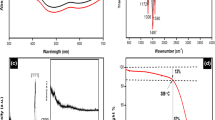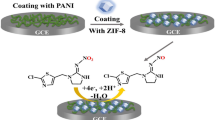Abstract
A label-free chemo-probe comprising carbon quantum dots/polyaniline (CQDs/PANI) nanocomposites was developed for the sensitive and selective detection of mercury ions (Hg2+). CQDs/PANI nanocomposites were synthesized through one-step complexation reaction method. Present work represents a thorough study of structural and functional properties of CQDs/PANI nanocomposites. CQDs/PANI nanocomposites consist of fibrous network type of structure with mean particle size of 53.09 nm. Polymer nanocomposites exhibit amorphous nature with average crystallite size of 5.19 nm. CQDs/PANI nanocomposites exhibit high thermal stability up to 750 °C. Raman spectroscopy was used in sensitive and selective detection of Hg2+ ions in dynamic range of 0.01–0.1 ppm. Limit of detection (LOD) and limit of quantification (LOQ) for Hg2+ ions were obtained to be 0.017–0.031 ppm, respectively. CQDs/PANI nanocomposite-based sensing probe was found to be highly effective in pH range 3–7 for detection of Hg2+ ions. The proposed sensing probe was positively tested in real soil samples for detection of Hg2+ ions. It has shown good reproducibility and all the recorded observations indicate that CQDs/PANI nanocomposites can act as potential candidate for sensing of Hg2+ ions in environmental applications.





Similar content being viewed by others
References
K.I. Winey, R.A. Vaia, Polym. Nanocomposites MRS. Bull. 32, 314 (2007)
S.C. Tjong, Synthesis and properties of nano-hydroxyapatite/polymer nanocomposites for bone tissue engineering, in Advances in Biomedical Sciences and Engineering. (Bentham Science Publishers Ltd, Sharjah, 2009), pp. 82–142
N. Pramanik, S. Mohapatra, S. Alam, P. Pramanik, Synthesis of hydroxyapatite/poly (vinyl alcohol phosphate) nanocomposite and its characterization. Polym. Compos. 29(4), 429 (2008)
K. Mallick, M.J. Witcomb, R. Erasmus, M.S. Scurrell, Hydrophilic behaviour of gold-poly (o-phenylenediamine) hybrid nanocomposite. Mater. Sci. Eng.: B. 140(3), 166 (2007)
S. Samanta, A.K. Nandi, Recyclable high performance palladium heterogeneous catalyst with porous PVDF binder from the novel gel nanocomposite route. J. Phys. Chem. C 113(11), 4721 (2009)
J. Macanas, J. Parrondo, M. Munoz, S. Alegret, F. Mijangos, D.N. Muraviev, Preparation and characterisation of metal–polymer nanocomposite membranes for electrochemical applications. Phys. Stat. sol. (a) 204(6), 1699 (2007)
F.Z. Yang, Y.C. Chen, Y.F. Lin, K.H. Yu, Y.H. Liu, Y. Wang, J.T. Chen, Nickel catalysts bearing bidentate α-aminoaldimines for ethylene polymerization—independent and cooperative structure/reactivity relationship resulting from unsymmetric square planar coordination. Dalton Trans. 7, 1243 (2009)
R.A. Hule, D.J. Pochan, Polymer nanocomposites for biomedical applications. MRS Bull. 32(4), 354 (2007)
J. Njuguna, K. Pielichowski, Polymer nanocomposites for aerospace applications: properties. Adv. Eng. Mater. 5(11), 769 (2003)
A.M. Youssef, Polymer nanocomposites as a new trend for packaging applications. Polym. Plast. Technol. Eng. 52(7), 635 (2013)
C. Fangmin, Z. Ningchun, X. Haiming, L. Yi, Z. Wenfang, Z. Zhiwei, C. Mingxue, Cadmium and lead contamination in japonica rice grains and its variation among the different locations in southeast China. Sci. Total Environ. 359(1–3), 156 (2006)
J. Huang, S. Virji, B.H. Weiller, R.B. Kaner, Nanostructured polyaniline sensors. Chem. Eur. J. 10(6), 1314 (2004)
S.Y. Lim, W. Shen, Z. Gao, Carbon quantum dots and their applications. Chem. Soc. Rev. 44(1), 362 (2015)
W.H. Schroeder, J. Munthe, Atmospheric mercury—an overview. Atmos. Environ. 32(5), 809 (1998)
Q. Wang, D. Kim, D.D. Dionysiou, G.A. Sorial, D. Timberlake, Sources and remediation for mercury contamination in aquatic systems—a literature review. Environ. Pollut. 131(2), 323 (2004)
M. Kumar, A. Puri, A review of permissible limits of drinking water. Indian J. Occup. Environ. Med. 16(1), 40 (2012)
A. Kudo, S. Miyahara, A case history; Minamata mercury pollution in Japan–from loss of human lives to decontamination. Water Sci. Technol. 23(1), 283 (1991)
G.V. Ramesh, T.P. Radhakrishnan, A universal sensor for mercury (Hg, HgI, HgII) based on silver nanoparticle-embedded polymer thin film. ACS Appl. Mater. Interfaces 3(4), 988 (2011)
X. Wang, J. Zhang, W. Zou, R. Wang, Facile synthesis of polyaniline/carbon dot nanocomposites and their application as a fluorescent probe to detect mercury. RSC Adv. 5(52), 41914 (2015)
Q. Wang, H. Wang, D. Liu, P. Du, P. Liu, Synthesis of flake-shaped nitrogen-doped carbon quantum dot/polyaniline (N-CQD/PANI) nanocomposites via rapid-mixing polymerization and their application as electrode materials in supercapacitors. Synth. Metals 231, 120 (2017)
A. Saikia, N. Karak, Polyaniline nanofiber/carbon dot nanohybrid as an efficient fluorimetric sensor for As(III) in water and effective antioxidant. Mater. Today Commun. 14, 82 (2018)
P. Viswanathan, Y. Muralidaran, G. Ragavan, Challenges in oral drug delivery: a nano-based strategy to overcome (Elsevier, Nanostructures for Oral Medicine, 2017), p. 173
B. Bhowmick, D. Mondal, D. Maity, M.M. Rahaman Mollick, M. Kanti Bain, N. Kumar Bera, D. Chattopadhyay, In situ fabrication of polyaniline-silver nanocomposites using soft template of sodium alginate. J. Appl. Polym. Sci. 129(6), 3551 (2013)
R. Abdelkader, H. Amine, B. Mohammed, Thermally stable forms of pure polyaniline catalyzed by an acid-exchanged montmorillonite clay called maghnite-H+ as an effective catalyst. Int. J. Polym. Sci. 2012, 1–7 (2012)
V. Sridevi, S. Malathi, C.S. Devi, Synthesis and characterization of polyaniline/gold nanocomposites. Chem. Sci. J. 26, 1 (2011)
N.A. Rangel-Vazquez, C. Sánchez-López, F.R. Felix, Spectroscopy analyses of polyurethane/polyaniline IPN using computational simulation (Amber, MM+ and PM3 method). Polímeros 24, 453 (2014)
S. Fathalipour, S. Ahunbar, Polyaniline-ag nanocomposite containing silane ligand: synthesis characterization and electroactivity behavior. Polym. Sci. Ser. B 61(5), 663 (2019)
U. Bogdanovic, I. Pašti, G. Ciric-Marjanovic, M. Mitric, S.P. Ahrenkiel, V. Vodnik, Interfacial synthesis of gold–polyaniline nanocomposite and its electrocatalytic application. ACS Appl. Mater. Interfaces 7(51), 28393 (2015)
J. Liu, H. Bi, P.C. Morais, X. Zhang, F. Zhang, L. Hu, Room-temperature magnetism in carbon dots and enhanced ferromagnetism in carbon dots-polyaniline nanocomposite. Sci. Rep. 7(1), 1 (2017)
K.L. Bhowmik, K. Deb, A. Bera, R.K. Nath, B. Saha, Charge transport through polyaniline incorporated electrically conducting functional paper. J. Phys. Chem. C 120(11), 5855 (2016)
S.M. Ambalagi, M. Devendrappa, S. Nagaraja, B. Sannakki, Dielectric properties of PANI/CuO nanocomposites. IOP Conf. Ser.: Mater. Sci. Eng. 310(1), 012081 (2018)
A. Olad, M. Khatamian, B. Naseri, Removal of toxic hexavalent chromium by polyaniline modified clinoptilolite nanoparticles. J. Iran. Chem. Soc. 8(1), S141 (2011)
V.H. Nguyen, J.J. Shim, Green synthesis and characterization of carbon nanotubes/polyaniline nanocomposites. J. Spectrosc. 2015, 1–9 (2015)
M.J. Chatterjee, A. Ghosh, A. Mondal, D. Banerjee, Polyaniline–single walled carbon nanotube composite—a photocatalyst to degrade rose bengal and methyl orange dyes under visible-light illumination. RSC Adv. 7(58), 36403 (2017)
A. Shakoor, T.Z. Rizvi, Raman spectroscopy of conducting poly (methyl methacrylate)/polyaniline dodecylbenzenesulfonate blends. J. Raman Spectrosc.: Int. J. Orig. Work Asp. Raman Spectrosc. Incl. High. Ord. Process. Brillouin Rayleigh Scatt. 41(2), 237 (2010)
L. Dennany, P.C. Innis, S.T. McGovern, G.G. Wallace, R.J. Forster, Electronic interactions within composites of polyanilines formed under acidic and alkaline conditions conductivity, ESR, Raman, UV-vis and fluorescence studies. Phys. Chem. Chem. Phys. 13(8), 3303 (2011)
A. Nautiyal, S. Parida, Comparison of polyaniline electrodeposition on carbon steel from oxalic acid and salicylate medium. Prog. Org. Coat. 94, 28 (2016)
M.-C. Bernard, A.-L. Goff, Raman spectroscopy for the study of polyaniline. Synth. Metal. 85, 1145 (1997)
M.I. Boyer, S. Quillard, E. Rebourt, G. Louarn, J.P. Buisson, A. Monkman, S. Lefrant, Vibrational analysis of polyaniline: a model compound approach. J. Phys. Chem. B 102(38), 7382 (1998)
J. Stejskal, M. Trchová, P. Bober, P. Humpolíček, V. Kašpárková, I. Sapurina, M.A. Shishov, M. Varga, Conducting polymers: polyaniline. Encycl. Polym. Sci. Technol. (2002). https://doi.org/10.1002/0471440264.pst640
G.K. Darbha, A.K. Singh, U.S. Rai, E. Yu, H. Yu, P. Chandra Ray, Selective detection of mercury (II) ion using nonlinear optical properties of gold nanoparticles. J. Am. Chem. Soc. 130(25), 8038 (2008)
H. Yu, J. Li, Y. Luan, Meta-analysis of soil mercury accumulation by vegetables. Sci. Rep. 8(1), 1261 (2018)
L. Cherian, V.K. Gupta, A simple field test for the detection of mercury in polluted water, air and soil samples. Fresenius’ J. Anal. Chem. 336(5), 400 (1990)
Acknowledgements
The authors of this paper would like to acknowledge Prof. (dr.) Lalit Kumar Awasthi (Director, National Institute of Technology, Hamirpur, India) for his constant support.
Funding
No funding from any external source.
Author information
Authors and Affiliations
Corresponding author
Ethics declarations
Conflict of interest
The authors declare no conflict of interest.
Additional information
Publisher's Note
Springer Nature remains neutral with regard to jurisdictional claims in published maps and institutional affiliations.
Supplementary Information
Below is the link to the electronic supplementary material.
Rights and permissions
About this article
Cite this article
Singh, L., Singh, V. CQDs/PANI nanocomposites based sensing probe for the sensitive and selective detection of mercury ions via Raman spectroscopy. Appl. Phys. A 128, 610 (2022). https://doi.org/10.1007/s00339-022-05752-1
Received:
Accepted:
Published:
DOI: https://doi.org/10.1007/s00339-022-05752-1




